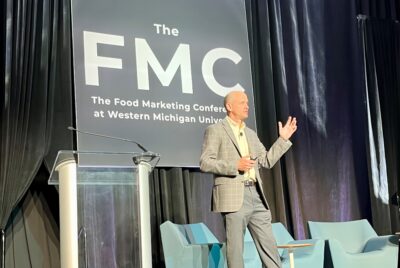Private brands have gained market share on national brands for three consecutive years, continuing a remarkable hot streak with no end in sight, according to the latest Private Brand Intelligence Report.
Consider this staggering fact: Today, 87% of shoppers say they buy private brands during every typical grocery trip, according to the research report, produced by Daymon, which powers private brand development for Advantage Solutions.
“Private brands have become essential solutions for shoppers’ growing appetite for innovation, value and quality,” said Jim Griffin, president of Daymon. “And at Advantage, we’re prepared to help retailers seize this moment in a multitude of ways.”
Gone are the days when shoppers turned up their noses at so-called generic brands. Now they’re increasingly reaching for private brands across categories. In the 52-week period ending June 29, private brands gained share in all departments — from fresh and frozen foods to items such as apparel, beauty products and pet care, the report shows.
And whereas they used to be a value play, today’s private brands are meeting different needs and desires for shoppers, such as wellness attributes and seasonal flavors, said Chelsey Capps, director of thought leadership for Daymon. In doing so, retailers’ private brands are driving traffic and building loyalty across generations of consumers.
“The beauty of private brands today is that they’ve developed beyond the branding of the store itself,” Capps said. “And they’re now true brands connecting with consumers emotionally, transcending demographics and income levels.”
Here are three key takeaways for retailers from this edition of the Private Brand Intelligence Report.
Time to woo Gen Z in the fresh food aisles
Their time has come (and will keep on coming). Generation Z is projected to be the largest generation with the highest spending growth, per NielsenIQ data. Gen Z is expected to expand categories and drive growth.
Here’s the unexpected part, though, from the PBIR: Despite their affinity for fresh, healthy and “Instagrammable” food, Gen Z’s fresh basket spend is actually down from a year ago — the only generation to decline in fresh spend compared to a year ago.
In fact, only 27% of Gen Z shoppers’ baskets are spent on fresh, per the report.
So what’s happening?
Despite their interest in global trends and healthy food, many Gen Z shoppers are still learning the basics of cooking, Capps said. They grew up during the proliferation of prepared meals at grocery stores and fast casual restaurants. They value convenience, as well as quick-meal solutions, best prices available, and targeted, trend-driven assortments.
The opportunity is ripe for retailers to meet their needs and fill their social media feeds with solutions such as pre-chopped veggies, unpasteurized juice and a variety of fresh salsas, Capps said. Retailers also could consider meats marinated with different global flavors — with recipes on the label — as another way to appeal to Gen Z shoppers.
Advantage, which helps retailers develop and promote new fresh food offerings for Gen Z, advises retailers to learn to “speak Gen Z” to best capitalize on social media trends.
“The first retailer to really blow this out is going to win big,” Capps said.
That’s “no cap,” as the kids would say. (Do they still say that?)
Private brand fashion hits the runway for takeoff
As with food, private brand general merchandise has come a long way.
Shoppers are now finding high-quality, on-trend clothing and apparel, as well as other home and design goods, particularly at big box retailers and club stores.
In other words, retailers are transforming their general merch from basic value offerings to highly sought-after goods. Private brand general merchandise saw some of the largest gains among all departments, ending with a 30.2% unit share in the 52-week period ending June 29, according to the PBIR report.
Look no further than Aldi’s “Aldidas” shoe line as one example highlighted in the report. Customers anticipate and even line up for the shoes, Capps said. In another unique crossover, the upscale Southern California-based grocer Erewhon partnered with Ugg to create a private brand beverage alongside a co-branded Ugg/Erewhon shoe.
More generally, private brand apparel is increasingly on-trend and higher-quality — and shoppers are taking note, Capps said.
Creating hot and desirable general merchandise offerings requires a longer runway for planning than food, Capps said. At Advantage, Daymon’s experts forecast trends years in advance by evaluating social trends, pop culture events, and other forms of analysis.
Of course, creating the products alone isn’t enough, she said. Retailers must invest in omnichannel marketing to lure in shoppers and build loyalty.
Daymon can help with that, too.
School lunches are a year-round opportunity
Parents, raise your hands if you’re already tired of making your kids’ school lunches.
Yep, that’s what we thought. Parents spend an average of $80 per child per week on school lunches, according to the PBIR report. And 91% of parents are committed to making healthier choices for their children.
But parents need more options throughout the year — and retailers can help.
Through private brand innovation, retailers can provide parents of school-age kids with healthier, more convenient and more creative solutions, Capps said. Retailers should consider lunch kits, snack pack sizes of salty-snack options, different formats of the ever-popular fruit snacks and other innovations.
Quality is paramount. After all, one negative experience could dampen enthusiasm not just for the product in question, but for the entire private brand and the retailer.
The good news: 85% of consumers perceive private brand quality to be as good as or better than national brands, according to the PBIR report.
“There’s a real opportunity to better strategize throughout the year on new flavors and develop products that are kid-focused,” Capps said. “Parents are all busy. We’re all strapped. How do you make it healthier and easier for them?”




